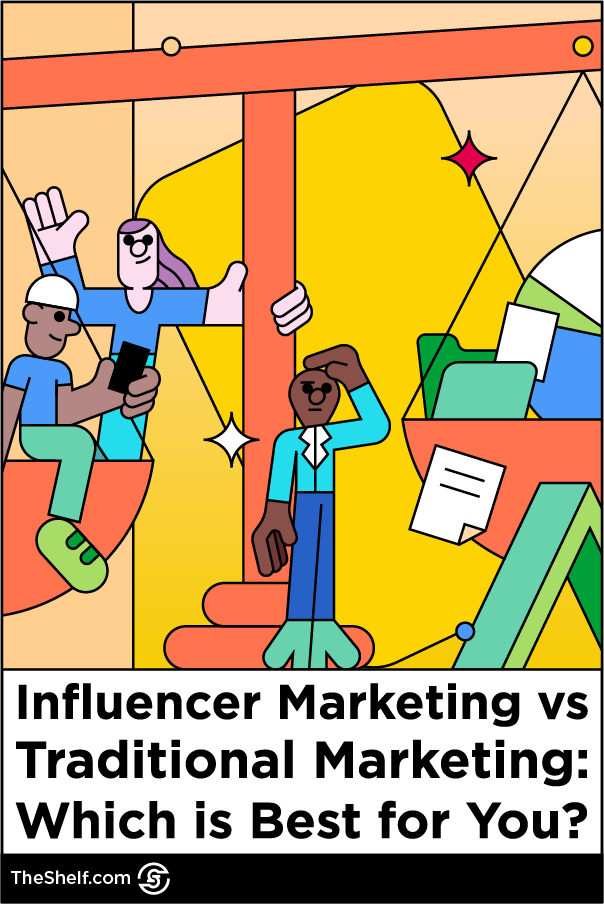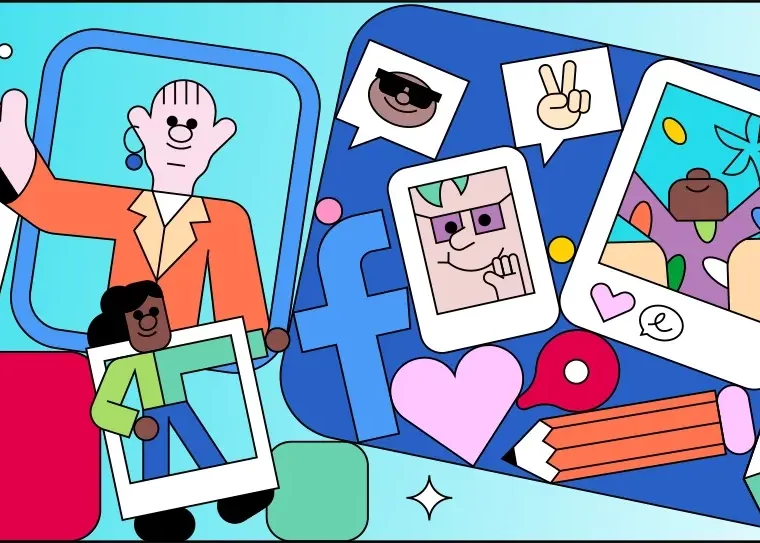Grabbing and keeping the attention of consumers seems to be more difficult now than ever. With shrinking attention spans and the growth of short and even shorter-form content, it can feel daunting to make the best decisions for your brand. We’ll simplify the decision making process for you by breaking down traditional marketing vs influencer marketing.
One of the highest-level choices marketers make these days is how to advertise. Do you go the traditional route and spend millions on commercials? Or do you target social media instead of traditional TV, out-of-home, or print ads? Should you hire commercial actors or influencers to be the face of your campaign? These are all great questions, and luckily for you, we have answers.
In this article, we’ll break down the differences between influencer marketing and traditional marketing, so you can make an informed decision on where to spend precious ad dollars for your next campaign. While here at The Shelf we’re partial to the influencer marketing buzz, we promise to give both types a fair shake, so you can choose which is best for you. Don’t be surprised if, by the end of this article, you’d like to use both!
Let’s dive in.
What’s the Difference Between Influencer Marketing and Traditional Marketing?

First, let’s define our terms. In the broadest strokes, influencer marketing is online and traditional marketing is offline. But it’s not that simple anymore. Traditional marketing techniques can be used across brands’ social media channels. And influencers can be cast in TV commercials, billboards, and other “traditional” ads. In 2023, there are plenty of ways to meld influencer and traditional marketing. But before we get into the potential of an influencer and traditional marketing swirl, let’s talk about the contrast between the two.
WHAT IS TRADITIONAL MARKETING?
Traditional marketing is, well traditionally, old methods of advertising like print ads, billboards, TV commercials, and radio spots. Think of traditional marketing as outbound. It takes consumers out of their regularly scheduled programming. Traditional marketing, whether online or off, is an interruption or an add-on to what the audience is already consuming.
For instance, say you’re watching your favorite sitcom only to be interrupted by a car commercial right at the most climactic scene! The commercial, an example of traditional marketing, takes you out of your activity and disrupts your show-watching experience. This might be annoying when you desperately want to know whether the protagonist gets the girl or gets fired or catches her sister stealing from the family safe. But it’s not necessarily a bad thing. By inserting the ad into a media experience you’re highly engaged in, you’re more likely to stick it out and watch the entire car commercial rather than changing the channel, so you can be sure you don’t miss it when your show comes back on.
Another distinct feature of traditional marketing is its breadth. While you can choose the channel or timeslot of your TV commercial to align with a show that reaches your target demographic, you’re casting a wide net. Therefore the content you’re creating isn’t as tailored or as bespoke.
Traditional marketing online can look like banner ads on the margins or in pop-ups of websites other than the brand’s home site. These essentially function as the print ads we see in newspapers in magazines. Another example could be commercial-like video ads that play before YouTube videos. The tactics, budgets, and intent of ads like these mirror the strategies of old-guard traditional marketing in the social media sphere — and of course, they don’t typically cast influencers.
WHAT IS INFLUENCER MARKETING?
Influencer marketing, on the other hand, is fresh, new, and digitally native. This tactic refers to social media marketing that leverages the followings of influencers. It takes word-of-mouth advertising to a whole new level. Influencers develop trust with their niche audiences by creating engaging and entertaining content that audiences find authentic and reliable.
Influencer followings come in a range of sizes and niches, so you can get very specific with who exactly you’re targeting and how much you want to spend. You have the option to cast a wide net with mega influencers, whose followings rival the reach of traditional advertising methods, but you can also go much more granular and focused if you choose.
Influencer marketing is considered inbound because instead of interrupting your consumers’ experience with another form of media, the best influencer marketing creates an entertaining and valuable experience for the consumer — that the consumers actually want. Instead of taking you out of your element, it adds to it.
Another distinct difference is that influencer marketing puts consumers in the driver’s seat. Your target audience chooses which influencers they follow, and therefore the type of products they’ll be advertised. As most influencer marketing is consumed on social media sites accessed via mobile devices, each influencer ad can be skipped with a simple swipe of the thumb. Because it’s easier for consumers to skip or provide negative feedback to influencer marketing, the influencer ads themselves must be highly engaging and entertaining to encourage the audience to stick around and watch.
Influencer marketing includes any social posts made by an influencer. This spans all the different social media networks and post types. Think everything from a trendy, transition-heavy TikTok video to a highly professional text-heavy LinkedIn post. There are influencers for every niche, platform, and brand desire.
Traditional Marketing Pros
Traditional marketing is a tale as old as time. It’s tried and true and has worked for decades. And even with the booming social media presence in our daily lives, traditional marketing isn’t going anywhere any time soon. It allows you to cast a wide net and reach a large variety of demographics within your audience in a single campaign. This means you can reach a more diverse audience with fewer assets. Traditional marketing strategies also allow you to retain full control of the creative at every step of the process. And they can be great for targeting hyper-local audiences.
There is a long, impressive history of traditional marketing full of crazy, cool, creative, and groundbreaking campaigns. If you want to live your Mad Men fantasy, traditional advertising can definitely deliver.
Traditional Marketing Cons
If the bulk of your target audience is younger — think millennial and gen z — traditional marketing may not be the most effective use of your budget. And speaking of budget, traditional marketing can be much more costly than its influencer counterpart. Traditional marketing generally has much longer lead times than digital alternatives, as print and TV spots require months of notice and approvals before publication. This, of course, expands your marketing timelines and likely decreases the number of campaigns you can run per fiscal year.
Additionally, it can be hard to track ROI on traditional marketing efforts. You can’t exactly track clicks on a radio commercial or determine how many people bought your product because they saw it on a billboard, so it can be harder to know just how effective your campaigns really are.
Influencer Marketing Pros
One of the greatest benefits of influencer marketing is that it doesn’t feel like marketing. Influencers promote products in ways that feel seamless to their audiences. Imagine a friend telling you about their favorite new lip balm. It’s not going to feel like a commercial for lip balm. This is your BFF we’re talking about! They have chapped lips that need balming just like yours, and you trust their opinion! The best influencer marketing feels like a conversation with a trusted pal.
Basically, influencers create high-quality, engaging, and often highly topical (re: trendy) content that provides social proof for a product. This is great for engaging your audience in a way that feels more organic than traditional methods.
Influencer marketing can also be highly targeted. Choose the influencers that align exactly with your target audience, and you’ll be able to find new consumers in any niche. Plus, because influencer marketing lead times are so much shorter, your campaigns can be much more iterative. Social posts allow you to try out different tactics and adapt on the fly based on real-time results. If you’re a big believer in chasing those ROI numbers, influencer marketing can deliver those data points.
Influencer Marketing Cons
Of course, all that glitters isn’t always gold. It’s not all sunshine and rainbows on the influencer marketing front. With the flexibility and affordability of influencer marketing comes a big relinquishment of control. The best influencer campaigns allow influencers to put their own spin on the promotion. That means you probably won’t be providing an exact script or slide-by-slide storyboard for your influencer to follow. And finding influencers you trust to accurately represent your brand can be difficult.
Choosing the wrong influencers can do a doozy on your brand’s reputation, but don’t fret! Influencer marketing agencies (like us!) can help you find the right influencers and drastically decrease the risk of hiring influencers you’ll regret working with.
Traditional Marketing Examples
Let’s compare some traditional and influencer marketing efforts from a singular brand.
Companies like Don Julio Tequila are able to create cinematic masterpieces like the video below with their traditional marketing budgets and creative teams. This commercial ran both on social media and out-of-home channels (aka TV commercial spots). And it’s clearly an artful and creatively impressive piece. You’ll notice that it’s more of an endorsement for the brand itself rather than for a single product. This is likely due to the breadth of uses and audiences this traditional-style commercial served.
Source: Don Julio Tequila on YouTube
And Don Julio Tequila applies traditional marketing tactics to its social channels for more than repurposing out-of-home ads. They also create social-specific ads like the one below. You’ll notice this is more than just social-specific, it’s also product-specific and therefore more targeted to a subset of Don Julio’s wider audience.
Source: @donjuliotequila on Instagram
You can see 5,870 people liked this Instagram ad for the brand’s Rosado. That’s a little less than 2 percent engagement when you consider the account’s 319k followers.
Influencer Marketing Example
Don Julio Tequila advertised the same product with popular influencer, Tefi Pessoa. While Tefi has a bit smaller Instagram following, boasting 229k followers at the time of writing, her sponsored post for the same product received a much higher engagement. With 8,450 likes, Tefi’s post earned an engagement of 3.7 percent. And she was able to put her own spin on the campaign, which her followers loved because it was authentically her.
Source: @hellotefi on Instagram
Is Influencer Marketing or Traditional Marketing Better for My Campaign?
Here at The Shelf, we’re obviously partial to all things social media marketing. It’s our bread and butter. But as we’ve established, it’s totally possible (and often even preferable!) to mix your traditional and influencer marketing strategies in the digital space.
However, there are some clear determining factors that can help if you truly need to choose either or. If you’re targeting a huge, diverse audience, you have a baller marketing budget, and you want to unleash your team with complete creative control, traditional marketing may be the way to go.
On the flip side, if you’re targeting a mostly young (millennial or gen z) audience that falls into a specific niche, it may make more sense to find influencers your consumers trust to promote your brand. If your marketing budget is a little light on cash, and you’re really looking to get the most bang for your buck and show your leaders tangible results, influencer marketing is a great option!
Influencer Vs. Traditional Marketing: The Good, The Better, and The Best
The truth is, there’s no one right way to market a product. Your specific campaign goals, budget, and brand identity make your marketing needs unique to your brand. And your target audience, where they fall in the marketing funnel, and how they most like to shop are all going to affect where and how you reach them. There’s a lot to consider, but the good news is whether you choose to go the traditional route or dive into the hip new world of influencer marketing, there are benefits to both. And you don’t have to choose just one!
Influencer marketing and traditional marketing offer distinct benefits. They’re both good options. One might be better than the other for your specific needs, and we hope this article helped you determine which strategy will best help you achieve your goals.
If you have any further questions, or you’d like help structuring your next campaign, schedule a strategy call with one of our experts. We can help point you in the right direction, especially if you think influencer marketing is the right move for your brand.

About This Author
Ariana Newhouse | B2B Writer
I am a freelance writer and comedian based in Los Angeles, and while making people laugh is my jam, it’s not always the company brand. So, I strive to make people feel something. My writing philosophy is collaborative, empathetic, and humanistic. At the end of the day, no matter the message, there are real people on both ends of the process.





